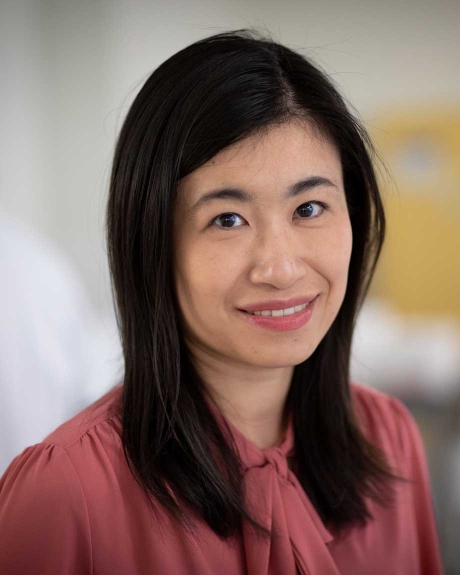
Danfeng (Dani) Cai
Imaging transcription and cellular organization
-
Academic Program Finder
-
Master's Degrees
- MSPH in Population, Family and Reproductive Health
- Master of Applied Science (MAS) in Patient Safety and Healthcare Quality
- Master of Applied Science (MAS) in Population Health Management
- Master of Applied Science (MAS) in Spatial Analysis for Public Health
- Master of Arts and Master of Science in Public Health (MA/MSPH)
- Master of Arts in Public Health Biology (MAPHB)
- Master of Bioethics (MBE)
- Master of Health Administration (MHA)
- Master of Health Science (MHS) - Department of Biochemistry and Molecular Biology
- Master of Health Science (MHS) - Department of Epidemiology
- Master of Health Science (MHS) - Department of Mental Health
- Master of Health Science (MHS) - Department of Molecular Microbiology and Immunology
- Master of Health Science (MHS) in Health Economics and Outcomes Research
- Master of Health Science (MHS) in Health, Behavior and Society
- Master of Health Science (MHS)
- Master of Health Science - Department of Biostatistics
- Master of Health Science - Department of Population, Family and Reproductive Health
- Master of Health Science in Global Health Economics
- Master of Public Health (MPH)
- Master of Science (ScM) - Department of Biochemistry and Molecular Biology
- Master of Science (ScM) - Department of Biostatistics
- Master of Science (ScM) - Department of Epidemiology
- Master of Science (ScM) - Department of Molecular Microbiology and Immunology
- Master of Science (ScM) in Genetic Counseling
- Master of Science in Public Health (MSPH) in Health Education and Health Communication
- Master of Science in Public Health (MSPH) in Health Policy
-
Master of Science in Public Health - Department of International Health
- Master of Science in Public Health (MSPH) in Global Disease Epidemiology and Control
- Master of Science in Public Health (MSPH) in Health Systems
- Master of Science in Public Health (MSPH) in Human Nutrition
- Master of Science In Public Health (MSPH) In Human Nutrition – Dietitian
- Master of Science in Public Health (MSPH) in Social and Behavioral Interventions
-
Doctoral Degrees
- Doctor of Philosophy (PhD) - Department of Biochemistry and Molecular Biology
- Doctor of Philosophy (PhD) - Department of Biostatistics
- Doctor of Philosophy (PhD) - Department of Epidemiology
- Doctor of Philosophy (PhD) - Department of Mental Health
- Doctor of Philosophy (PhD) - Department of Molecular Microbiology and Immunology
- Doctor of Philosophy (PhD) - Department of Population, Family and Reproductive Health
- Doctor of Philosophy (PhD) in Clinical Investigation
- Doctor of Philosophy (PhD) in Health Policy and Management
- Doctor of Philosophy (PhD) in Social and Behavioral Sciences
- Doctor of Philosophy - Department of International Health
- JHU-Tsinghua Doctor of Public Health
- Doctor of Public Health (DrPH)
- Combined / Dual Degrees
-
Certificate Programs
- Adolescent Health Certificate Program
- Bioethics Certificate Program
- Clinical Trials Certificate Program
- Community- Based Public Health Certificate Program
- Demographic Methods Certificate Program
- Epidemiology for Public Health Professionals Certificate Program
- Evaluation: International Health Programs Certificate Program
- Frequently Asked Questions for Certificate Programs
- Gender and Health Certificate Program
- Gerontology Certificate Program
- Global Digital Health Certificate Program
- Global Health Certificate Program
- Global Health Practice Certificate Program
- Health Communication Certificate Program
- Health Disparities and Health Inequality Certificate Program
- Health Education Certificate Program
- Health Finance and Management Certificate Program
- Healthcare Epidemiology and Infection Prevention and Control Certificate Program
- Humanitarian Health Certificate Program
- Implementation Science and Research Practice Certificate Program
- Injury and Violence Prevention Certificate Program
- Leadership for Public Health and Healthcare Certificate Program
- Lesbian, Gay, Bisexual, Transgender, and Queer (LGBTQ) Public Health Certificate Program
- Maternal and Child Health Certificate Program
- Mental Health Policy, Economics and Services Certificate Program
- Non-Degree Students General Admissions Info
- Pharmacoepidemiology and Drug Safety Certificate Program
- Population Health Management Certificate Program
- Population and Health Certificate Program
- Public Health Advocacy Certificate Program
- Public Health Economics Certificate Program
- Public Health Informatics Certificate Program
- Public Health Training Certificate for American Indian Health Professionals
- Public Health, Human Rights, and the Law Certificate Program
- Public Mental Health Research Certificate Program
- Quality, Patient Safety and Outcomes Research Certificate Program
- Requirements for Successful Completion of a Certificate Program
- Rigor, Reproducibility, and Responsibility in Scientific Practice Certificate Program
- Risk Sciences and Public Policy Certificate Program
- Social Epidemiology Certificate Program
- Spatial Analysis for Public Health Certificate Program
- Training Certificate in Public Health
- Tropical Medicine Certificate Program
- Tuition for Certificate Programs
- Vaccine Science and Policy Certificate Program
- Online Programs
- Accelerated Learning Institutes
- Postdoctoral Programs
- Residency Programs
- Graduate Training Programs in Clinical Investigation
- For Working Professionals
-
Training Grants
-
Mixed Methods Research Training Program for the Health Sciences
- About the Program
- Announcements
- Application Process
- Contact Us
-
Current Scholars
-
2015 Scholars
- Jennifer I Manuel, PhD, MSW
- Joke Bradt, PhD
- Josiemer Mattei, PhD, MPH
- Justin Sanders, MD, MSc
- Linda Charmaran, PhD
- Nao Hagiwara, PhD
- Nynikka R. A. Palmer, DrPH, MPH
- Olayinka O. Shiyanbola, BPharm, PhD
- Sarah Ronis, MD, MPH
- Susan D. Brown, PhD
- Tara Lagu, MD, MPH
- Theresa Hoft, PhD
- Wynne E. Norton, PhD
- Yvonne Mensa-Wilmot, PhD, MPH
-
2016 Scholars
- A. Susana Ramírez, PhD, MPH
- Animesh Sabnis, MD, MSHS
- Autumn Kieber-Emmons, MD, MPH
- Benjamin Han, MD, MPH
- Brooke A. Levandowski, PhD, MPA
- Camille R. Quinn, PhD, AM, LCSW
- Justine Wu, MD, MPH
- Kelly Aschbrenner, PhD
- Kim N. Danforth, ScD, MPH
- Loreto Leiva, PhD
- Marie Brault, PhD
- Mary E. Cooley, PhD, RN, FAAN
- Meganne K. Masko, PhD, MT-BC/L
- PhuongThao D. Le, PhD, MPH
- Rebecca Lobb, ScD, MPH
-
2017 Scholars
- Allegra R. Gordon, ScD MPH
- Anita Misra-Hebert, MD MPH FACP
- Arden M. Morris, MD, MPH
- Caroline Silva, PhD
- Danielle Davidov, PhD
- Hans Oh, PhD
- J. Nicholas Dionne-Odom, PhD RN ACHPN
- Jacqueline Mogle, PhD
- Jammie Hopkins, DrPH, MS
- Joe Glass, PhD MSW
- Karen Whiteman, PhD MSW
- Katie Schultz, PhD MSW
- Rose Molina, MD
- Uriyoán Colón-Ramos, ScD MPA
-
2018 Scholars
- Andrew Riley, PhD
- Byron J. Powell, PhD, LCSW
- Carrie Nieman MD, MPH
- Charles R. Rogers, PhD, MPH, MS, CHES®
- Emily E. Haroz, PhD
- Jennifer Tsui, Ph.D., M.P.H.
- Jessica Magidson, PhD
- Katherine Sanchez, PhD, LCSW
- Kelly Doran, MD, MHS
- Kiara Alvarez, PhD
- LaPrincess C. Brewer, MD, MPH
- Melissa Radey, PhD, MA, MSSW
- Sophia L. Johnson, PharmD, MPH, PhD
- Supriya Gupta Mohile, MD, MS
- Virginia McKay, PhD
-
2019 Scholars
- Andrew Cohen, MD, PhD
- Angela Chen, PhD, PMHNP-BC, RN
- Christopher Salas-Wright, PhD, MSW
- Eliza Park MD, MS
- Jaime M. Hughes, PhD, MPH, MSW
- Johanne Eliacin, PhD, HSPP
- Lingrui Liu ScD MS
- Meaghan Kennedy, MD
- Nicole Stadnick, PhD, MPH
- Paula Aristizabal, MD
- Radhika Sundararajan, MD
- Sara Mamo, AuD, PhD
- Tullika Garg, MD MPH FACS
-
2020 Scholars
- Allison Magnuson, DO
- Ariel Williamson PhD, DBSM
- Benita Bamgbade, PharmD, PhD
- Christopher Woodrell MD
- Hung-Jui (Ray) Tan, MD, MSHPM
- Jasmine Abrams, PhD
- Jose Alejandro Rauh-Hain, MD
- Karen Flórez, DrPH, MPH
- Lavanya Vasudevan, PhD, MPH, CPH
- Maria Garcia, MD, MPH
- Robert Brady, PhD
- Saria Hassan, MD
- Scherezade Mama, DrPH
- Yuan Lu, ScD
- 2021 Scholars
-
2015 Scholars
- Resources
- Sign Up for Our Email List
-
Mixed Methods Research Training Program for the Health Sciences
-
Master's Degrees
- Course Directory
- Academic Calendar
- Hybrid Campus
- Convocation
- Lecture Series
Assistant Professor
Department of Biochemistry and Molecular Biology
Bloomberg School of Public Health

Research Overview
The Cai Lab focuses on understanding how the transcription process is regulated in normal and cancer cells. We are intrigued by the discoveries in our lab that many transcription factors involved in cancers can form small, liquid-like condensates in the nucleus to activate transcription. Our results are consistent with an emerging and paradigm-shifting view in biology: many biochemical reactions inside the living cell are organized in liquid-like condensates formed by weak protein and nucleic acid interactions. This implies that the material states as well as the components of cellular assemblies matter for their functions. We develop and employ many cutting-edge imaging tools in the lab, such as super resolution microscopy, single particle tracking, and optogenetics. By studying these condensates, we hope to understand how transcription is differentially organized in normal and cancer cells, and how we can target these condensates for cancer therapies.
Selected Publications
- Ye S, Benhamou Goldfajn N, So CL, Inoue T, Cai D. Rainbow Nucleus Charts Dynamic Interactome of Membrane-less Organelles (preprint). bioRxiv, 2025.
- So CL, Lee YJ, Vokshi BH, Chen W, Huang B, De Sousa E, Gao Y, Portuallo ME, Begum S, Jagirdar K, Linehan WM, Rebecca VW, Ji H, Toska E*, Cai D*. TFE3 fusion oncoprotein condensates drive transcriptional reprogramming and cancer progression in translocation renal cell carcinoma. Cell Reports, 2025. *co-corresponding authors.
- Hao S, Lee YJ, Benhamou Goldfajn N, Flores E, Liang J, Fuehrer H, Demmerle J, Lippincott-Schwartz J, Liu Z, Sukenik S, Cai D. YAP condensates are highly organized hubs. iScience. 2024.
- Cai D, Liu Z, Lippincott-Schwartz J. Biomolecular Condensates and Their Links to Cancer Progression. Trends in Biochemical Sciences, 2021.
- Cai D, Feliciano D, Dong P, Flores E, Gruebele M, Porat-Shliom N, Sukenik S, Liu Z, Lippincott-Schwartz J. Phase separation of YAP reorganizes genome topology for long-term YAP target gene expression. Nature Cell Biology, 2019.
